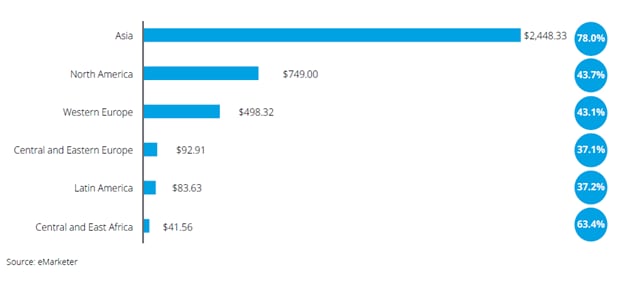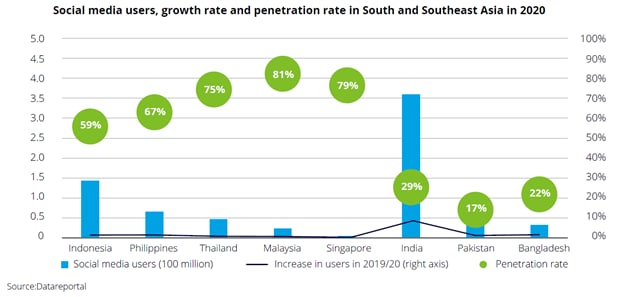- The burgeoning digital economy led the pandemic recovery in South and Southeast Asia.
- Heavy smartphone penetration is facilitating digitalization in these regions.
- Greater government support is needed to advance the digitalization process.
Digital transformation worldwide was already increasingly changing how companies make and offer their propositions and interact with their customers. But the COVID-19 pandemic has intensified this, with technology emerging as a critical means of resolving public health challenges and continuing to facilitate the new online consumer landscape. This accelerated digitalization is disrupting the world’s economy, making it one of the most significant growth engines for many developing nations.
We are already seeing how digitalization is reshaping Asia. The digital transformation of South and Southeast Asia is opening a range of opportunities for its citizens, especially for younger generations. Many Asian countries are even in the lead globally in certain sectors of digitalization. For example, the Philippines and Malaysia have become the top two countries in e-commerce retail growth, increasing by 25% and 23% per year, respectively.

What’s more, with the advent of rapid digitalization, Asian countries like India, Bangladesh, Pakistan and the Philippines are tapping new opportunities by exporting online labour to the West. In Bangladesh, for example, the digital economy is bringing employment to hitherto excluded sections of the population.
The pandemic effect
During the COVID-19 pandemic, digital connectivity in Asia played a vital role in overcoming the difficulties of conventional trade. The digital economy acted as a key enabling factor in the Asian recovery, Observer Research Foundation reports. According to Nikkei Asia, the pandemic has had a striking impact on Southeast Asia’s digital economy: 60 million people in the region became online consumers during this period. With this accelerated uptake of technology, there was an increase in nearly all e-commerce during the pandemic, with solid growth in sports equipment and supermarket items.

Asia now accounts for nearly 60% of the world’s online retail sales. Asian-Pacific e-commerce is expected to nearly double by 2025, reaching $2 trillion, according to Euromonitor International. From online retail to ride-sharing services to exporting online labour, this digital boom is reshaping almost every aspect of business and social life in this region.
The smartphone gateway
Asia, the most populous continent, has the most significant number of mobile phone users globally; around two-thirds of people use mobile services, and there is still room for further expansion. The fastest growth rates are in South and Southeast Asian countries.

The use of smartphones is quite common across most emerging economies. Countries like Singapore (87%), Malaysia (83%), and Thailand (75%) have comparatively higher smartphone penetration. However, in the case of smartphone market growth in 2020, the Philippines has the highest increase: over 90%. Similarly, according to GSMA, the consumption of mobile data in South and Southeast Asia will increase by three times by 2025, from 9.2 GB to 28.9 GB per month per user.
The UN-ESCAP reports that Asia is the fastest-growing region in the global e-commerce marketplace. In fact, the graph below shows that around 78% of Asia’s $2.448 trillion of e-commerce retail sales take place via mobile phones.

Southeast Asia leads social media
Social media has been another driving force in digitalization on the continent – but the penetration rate in Southeast Asia is much higher than that of in South Asia. For instance, Malaysia has the highest social media penetration rate (81%) in Southeast Asia, followed by Singapore (79%); the Philippines (67%) and Indonesia (59%) also feature strongly. But, in South Asia, the highest-ranking nations, India and Bangladesh, only have penetration rates of 29% and 22%, respectively.

In terms of duration, the Philippines spends more time on social media than other countries in the region: approximately three hours and 53 minutes daily.

The rise in digital consumption
Four factors have contributed to the rapid growth in digital consumption in South and Southeast Asia. Firstly, a vast youth population who are digital natives has significantly contributed to the growth of the sector. Secondly, the rapid adoption of financial services accessible via smartphones is helping millions of people make digital payments. Thirdly, with such high mobile penetration in the region, consumers regularly use e-commerce and social media sites to buy products and services. In fact, McKinsey & Company estimate that the proportion of digital payments in Asia will be at 65% in 2024 (against an average of 52% globally), making the continent the world’s consumption growth engine.

Finally, most governments in South and Southeast Asian countries have introduced supportive policies to boost the digital economy and infrastructure.
Asia’s digital horizon
There is no doubt that South and Southeast Asia are experiencing rapid digital growth. However, to achieve the region’s maximum potential, several areas need to be improved: digital infrastructure; new consumer development; information security; and effective digital policy. Moreover, many experts currently argue that digitalization is favouring individual consumers, not SMEs.
The region should adopt more cross-country collaborations, such as Go Digital ASEAN. These kinds of initiatives undeniably broaden the landscape of the digital economy and boost related infrastructures in the region. Meanwhile, national-level strategies like India’s National Digital Communication Policy (2018), 1st Policy for Digital Pakistan (2018), and Bangladesh’s National ICT Strategy need to be fully implemented and monitored as an utmost priority. Finally, South and Southeast Asian governments should foster a more sustainable digital ecosystem by promoting digital start-ups, removing entry barriers, developing human capital, and establishing national regulatory frameworks for the digital economy.
Azaz Zaman, Assistant Professor, Bangladesh Army International University of Science and Technology.
The article was originally published in the World Economic Forum.
Also read: No resources or publishing rights: Why international readers are missing Indian translations



